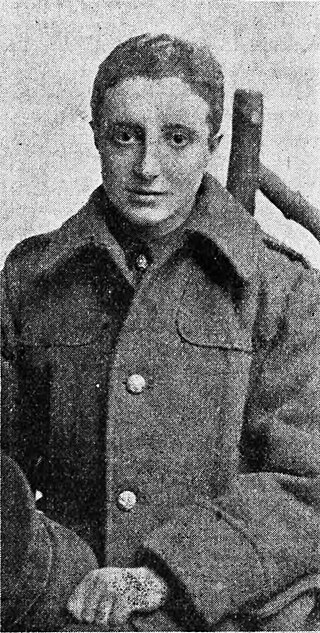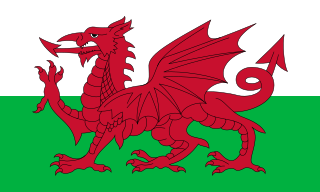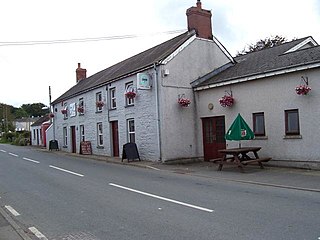
Saunders Lewis was a Welsh politician, poet, dramatist, Medievalist, and literary critic. He was a prominent Welsh nationalist, supporter of Welsh independence and was a co-founder of Plaid Genedlaethol Cymru, later known as Plaid Cymru. Lewis is usually acknowledged as one of the most prominent figures of 20th century Welsh literature. In 1970, Lewis was nominated for a Nobel Prize in Literature. Lewis was voted the tenth greatest Welsh hero in the '100 Welsh Heroes' poll, released on St. David's Day 2004.

The Welsh Language Society is a direct action pressure group in Wales campaigning for the right of Welsh people to use the Welsh language in every aspect of their lives. The chair of the Welsh Language Society since October 2023 is Joseff Gnagbo.

Gwynfor Richard Evans was a Welsh politician, lawyer and author. He was President of the Welsh political party Plaid Cymru for thirty-six years and was the first member of Parliament to represent it at Westminster, which he did twice, from 1966 to 1970, and again from 1974 to 1979.

Welsh nationalism emphasises and celebrates the distinctiveness of Welsh culture and Wales as a nation or country. Welsh nationalism may also include calls for further autonomy or self-determination, which includes Welsh devolution, meaning increased powers for the Senedd, or full Welsh independence.
Robert Maynard Jones, generally known as Bobi Jones, was a Welsh Christian academic and one of the most prolific writers in the history of the Welsh language. A versatile master of poetry, fictional prose and criticism, he was born in Cardiff in 1929, educated at the University of Wales, Cardiff and University College Dublin. Jones held the chair in Welsh language at Aberystwyth from 1980 until his retirement. He died on 22 November 2017.
Robert Geraint Gruffydd FLSW FBA was a scholar of Welsh language and literature. From 1970 to 1979, he was Professor of Welsh Language and Literature at the University of Wales, Aberystwyth, and was made Emeritus Professor in 1993.
The Cymru Fydd movement was founded in 1886 by some of the London Welsh. Some of its main leaders included David Lloyd George, J. E. Lloyd, O. M. Edwards, T. E. Ellis, Beriah Gwynfe Evans and Alfred Thomas. Initially it was a purely London-based society, later expanding to cities in England with a large Welsh population.

Undeb Cenedlaethol Athrawon Cymru is a trade union for teachers and lecturers in Wales. It was formed in December 1940, when a number of teachers in Wales felt that the teaching unions which they belonged to, did not give due respect to the Welsh language. The union performs all the functions of a teaching union - negotiating the salary of members, campaigning for better working conditions, supporting members. Its administration is conducted through the medium of the Welsh language. Throughout its history, UCAC has campaigned for Welsh-medium education and an independent education system for Wales.

Talgarreg is a small village in the community of Llandysiliogogo, in the county of Ceredigion, Wales. The village is located on a junction of the B4459, approximately half way between New Quay and Llandysul.

Beriah Gwynfe Evans was a journalist, Congregationalist, dramatist, Liberal politician and Welsh Nationalist.

Plaid Ifanc is the youth and student wing of Plaid Cymru, a political party in Wales.

The modern history of Wales starts in 1800 and continues until the present day. In the 19th century, South Wales became heavily industrialised with ironworks; this, along with the spread of coal mining to the Cynon and Rhondda valleys from the 1840s, led to an increase in population. The social effects of industrialisation resulted in armed uprisings against the mainly English owners. Socialism developed in South Wales in the latter part of the century, accompanied by the increasing politicisation of religious Nonconformism. The first Labour Party MP, Keir Hardie, was elected as a junior member for the Welsh constituency of Merthyr Tydfil and Aberdare in 1900.
Gethin ap Gruffydd is a Welsh political and cultural activist, born in Merthyr Tydfil.
Y Cofiadur is published by Cymdeithas Hanes Annibynwyr Cymru, a society founded in 1920 by Undeb yr Annibynwyr Cymraeg. The first issue was published in 1923. It is an annual Welsh-language magazine on the history of religion and contains articles on the history of Welsh Independent churches and the individuals involved, with references. It also includes society notes. The magazine has been digitised by the Welsh Journals Online project at the National Library of Wales.
Eileen Beasley was a Welsh teacher who, along with her husband Trefor, conducted a campaign of civil disobedience in the 1950s against the Rural District Council of Llanelli in a demand for council rate bills in the Welsh language. Her stand has led Welsh language campaigners to describe her as the "mother of direct action" and her protest helped to lead to the creation of Cymdeithas yr Iaith Gymraeg.
Trefor Richard Morgan was a Welsh nationalist activist. He was a businessman who set up an insurance company and also supported efforts around Welsh language schooling.
Gwenan Jones was a Welsh cultural historian, and was the first woman to stand in a general election for Plaid Cymru.

Alice Gray Jones, OBE was a Welsh writer and editor, known by the pseudonym Ceridwen Peris. She was an active temperance campaigner, and a co-founder of the North Wales Women's Temperance Union.









